High Victorian Literature (1837 – 1870) 1

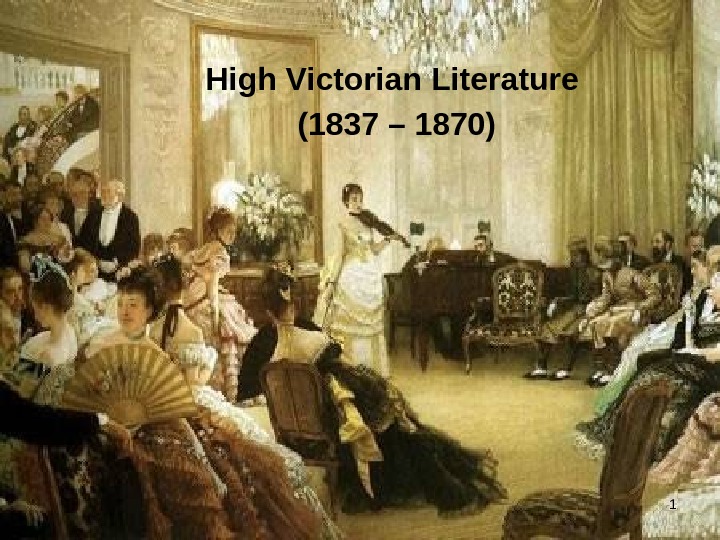
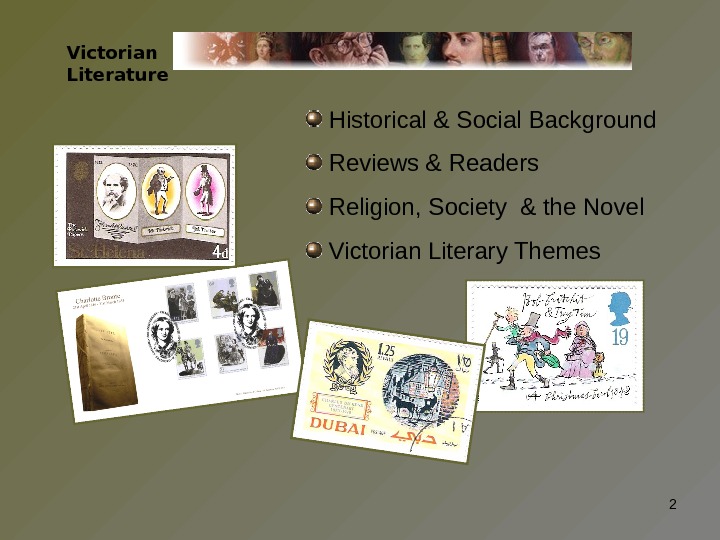
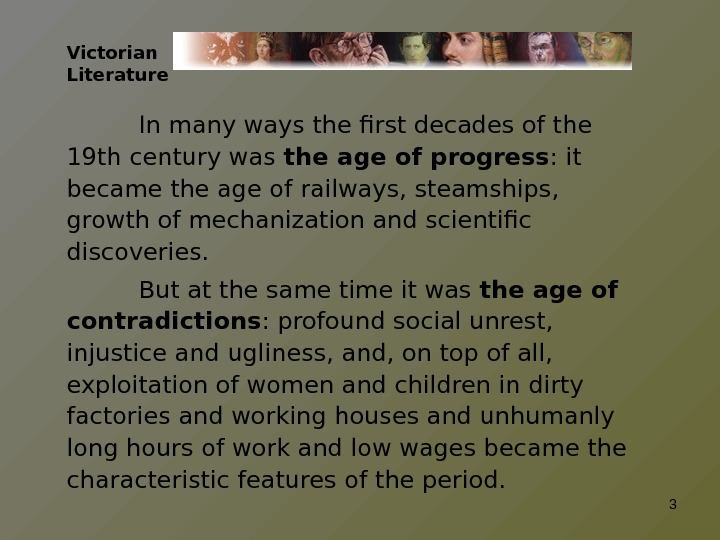
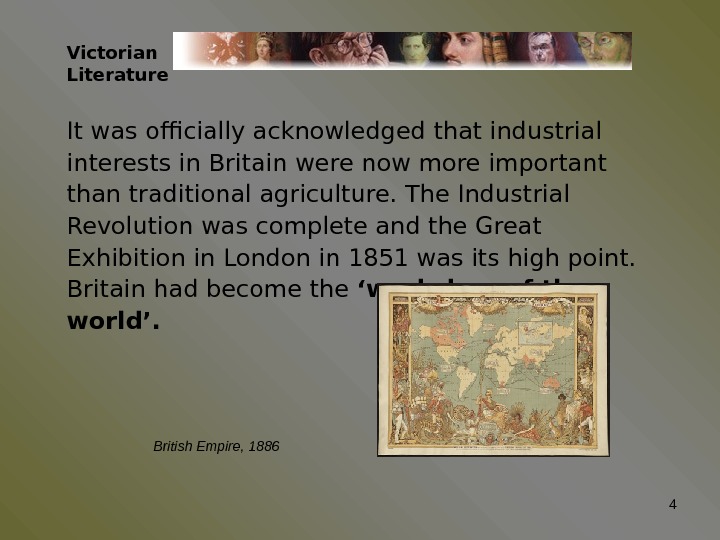
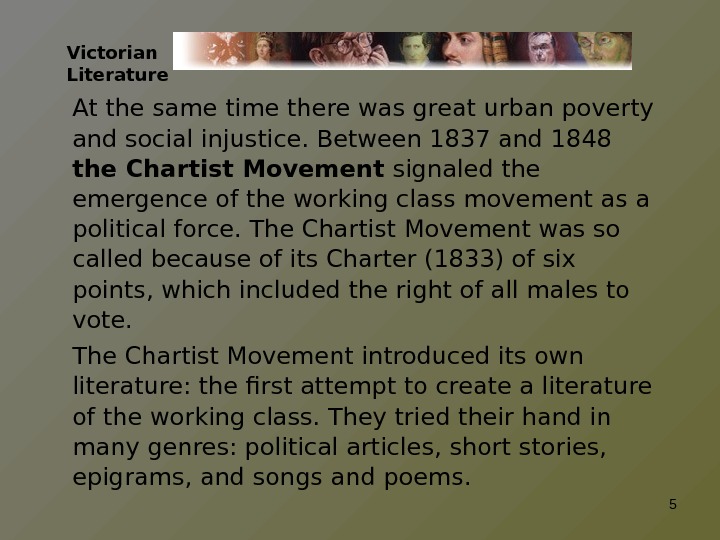
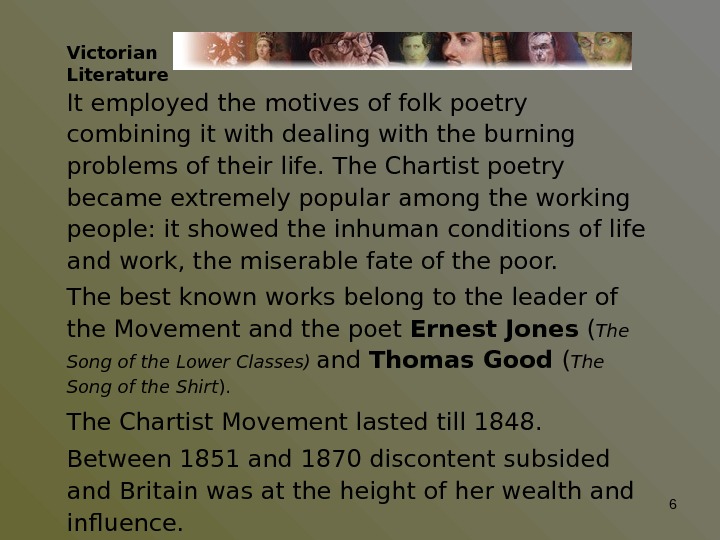
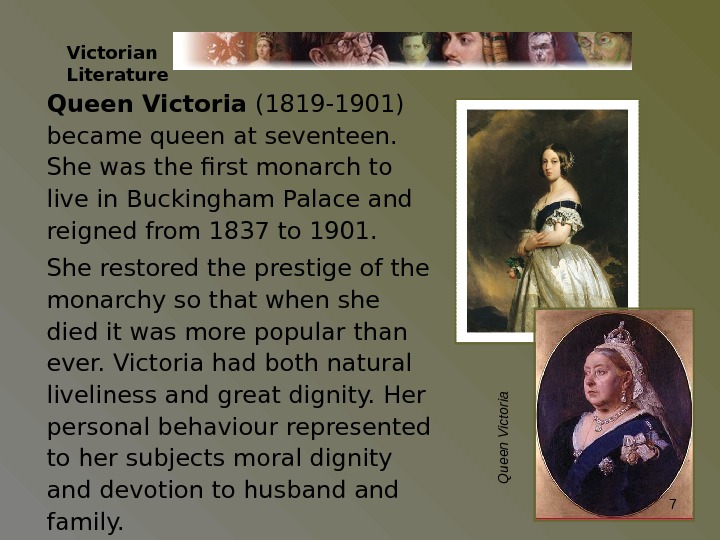
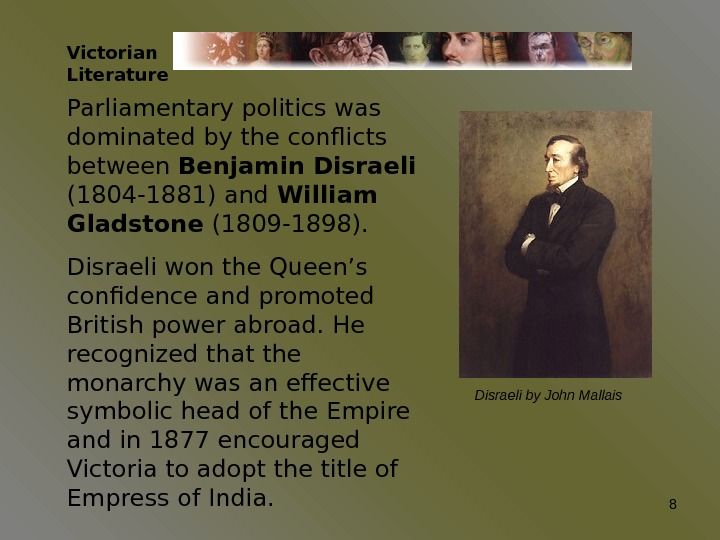
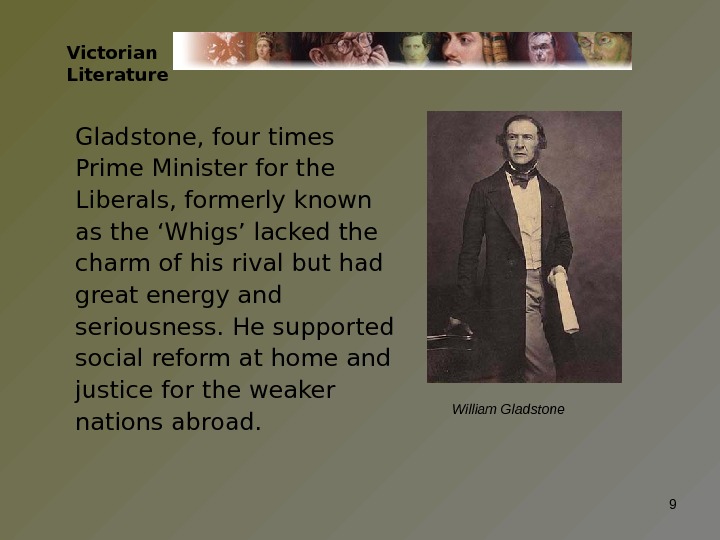
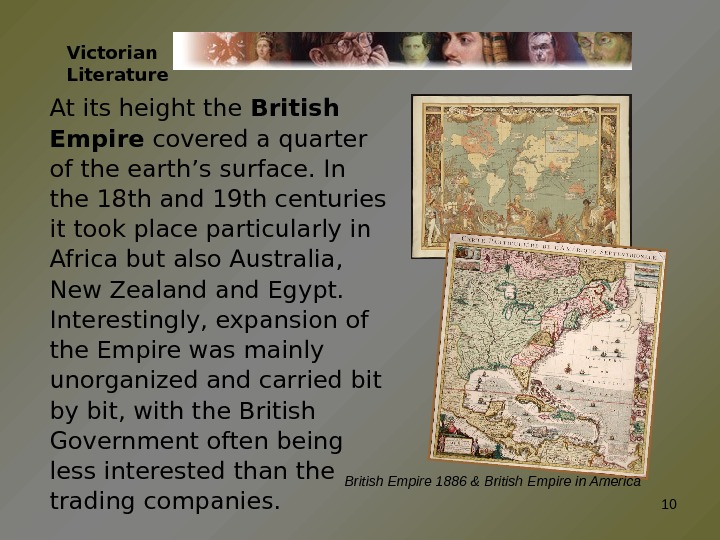
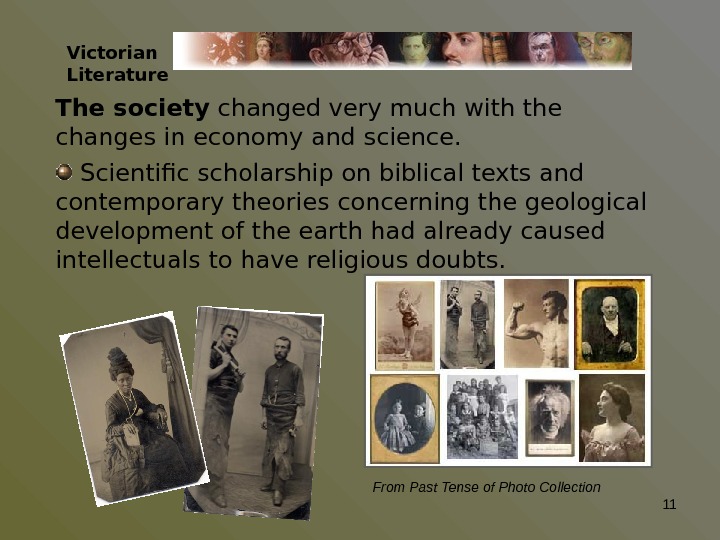
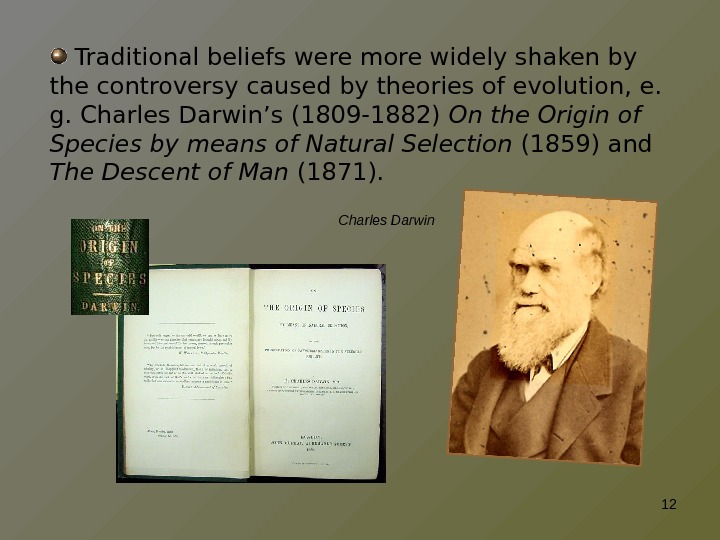
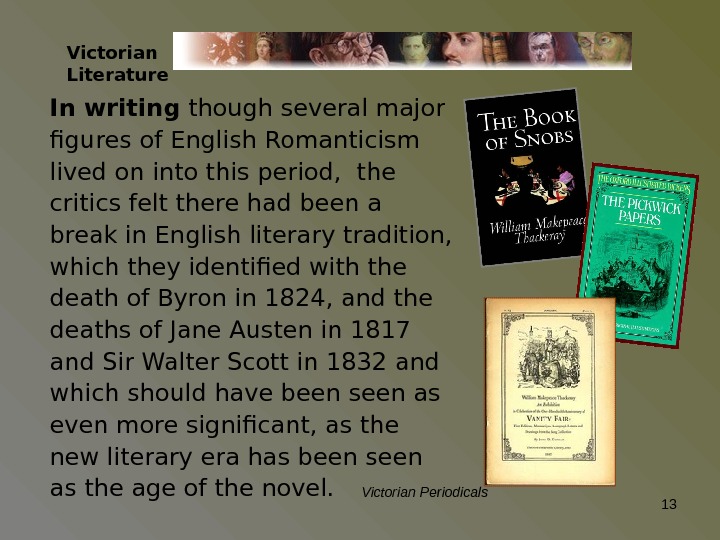
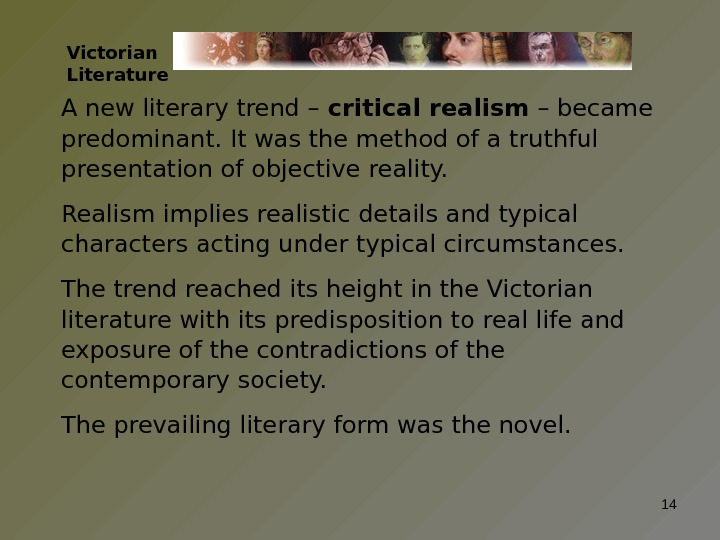
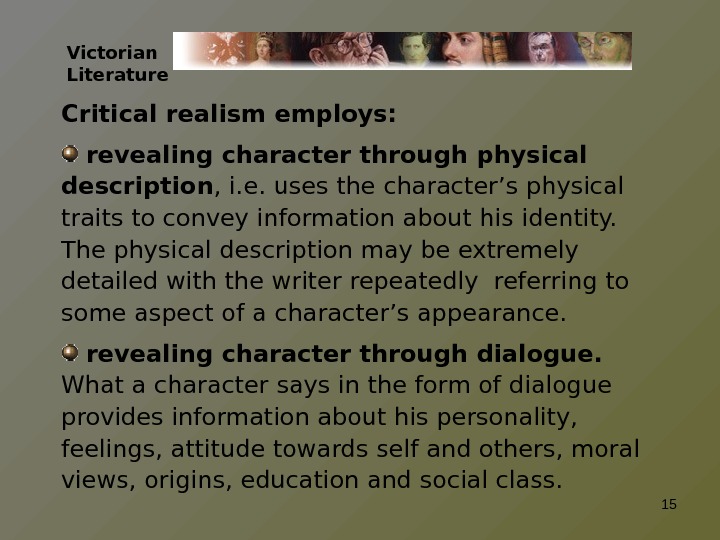
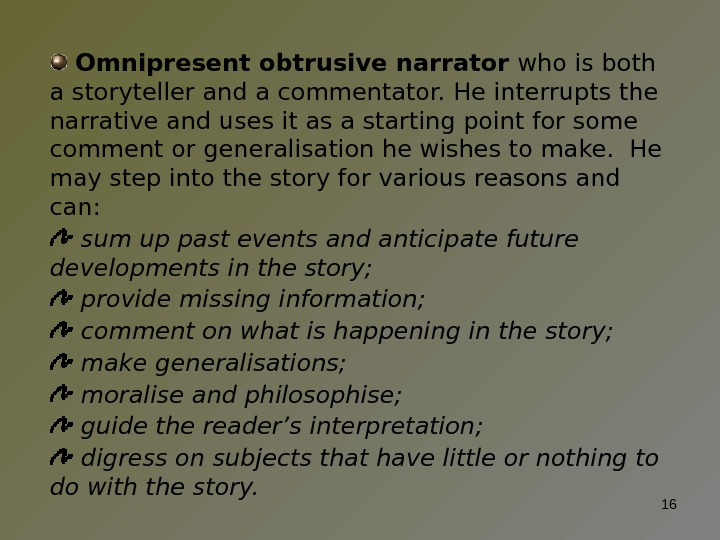
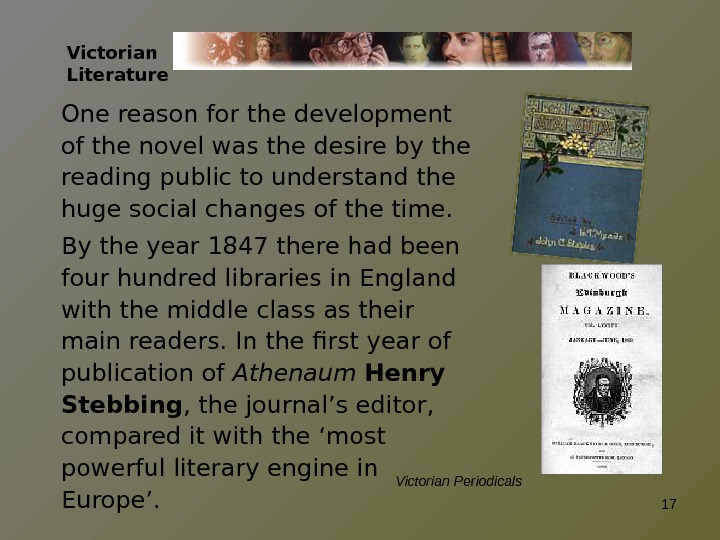
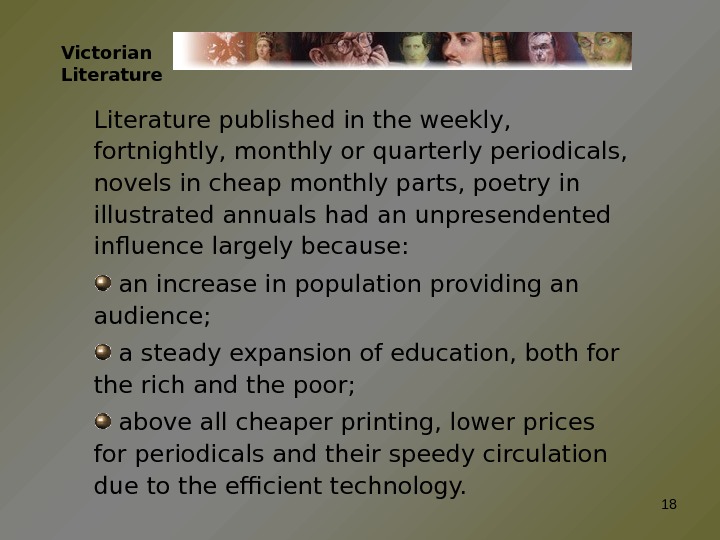
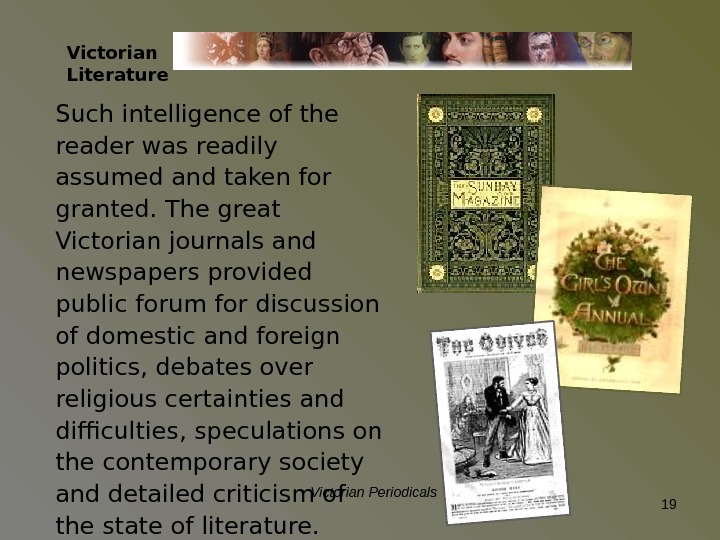
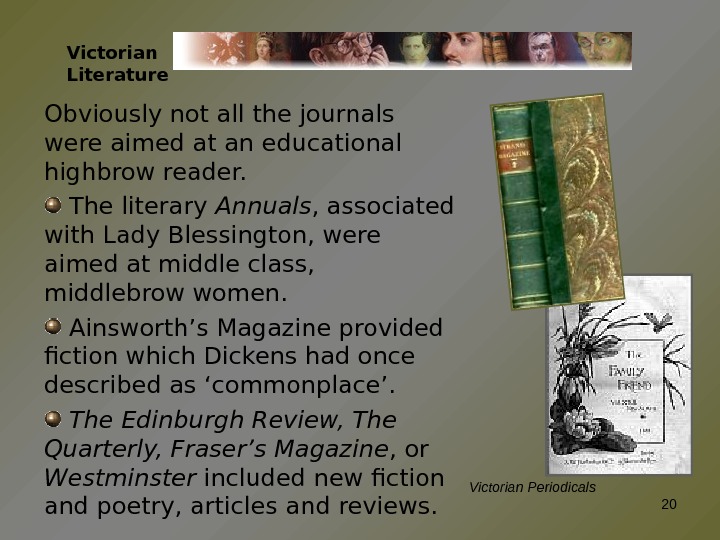
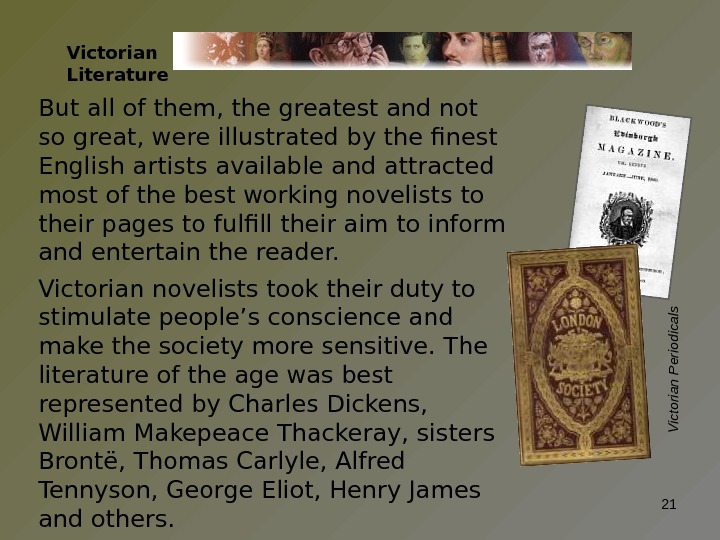
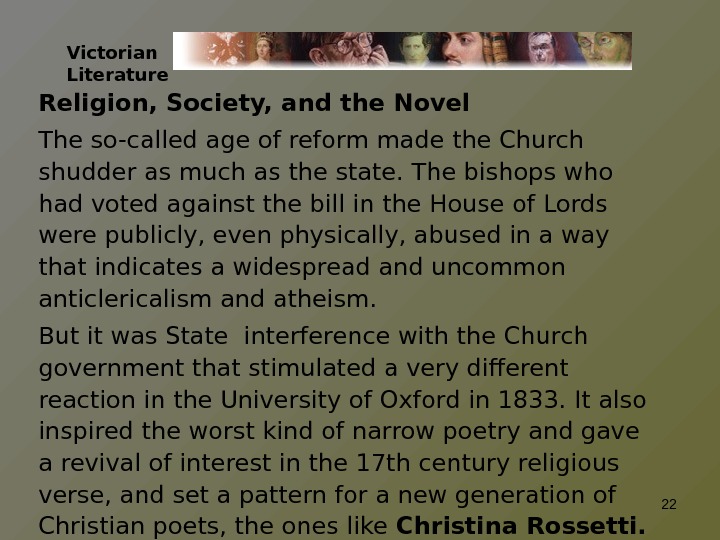
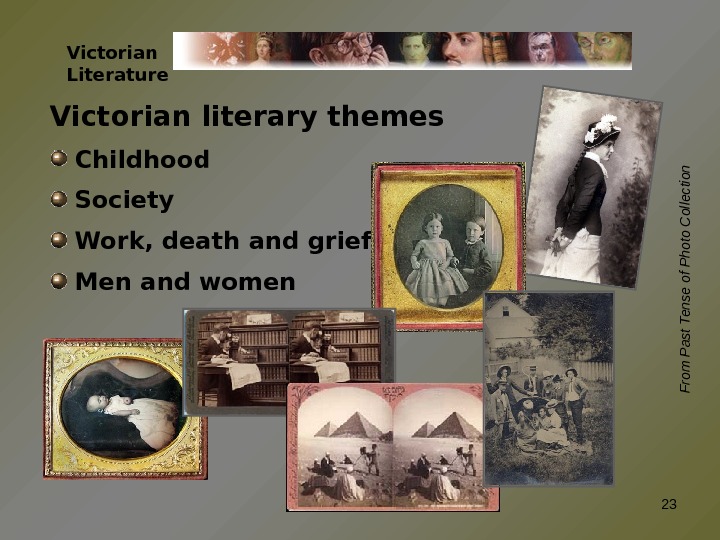
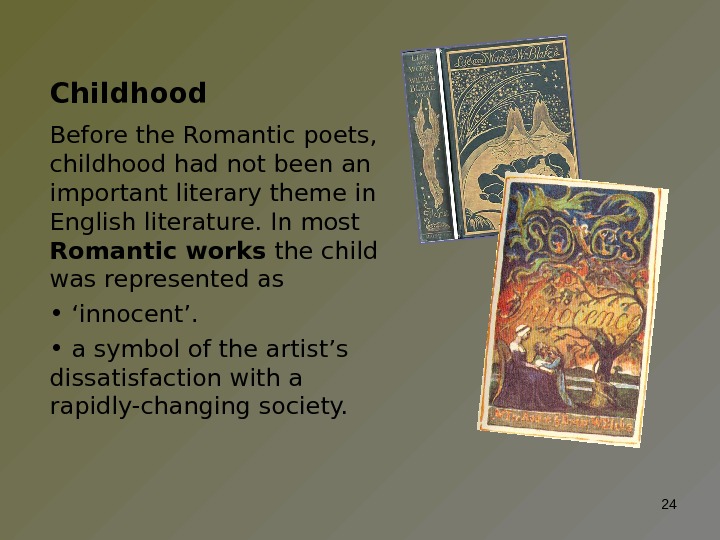
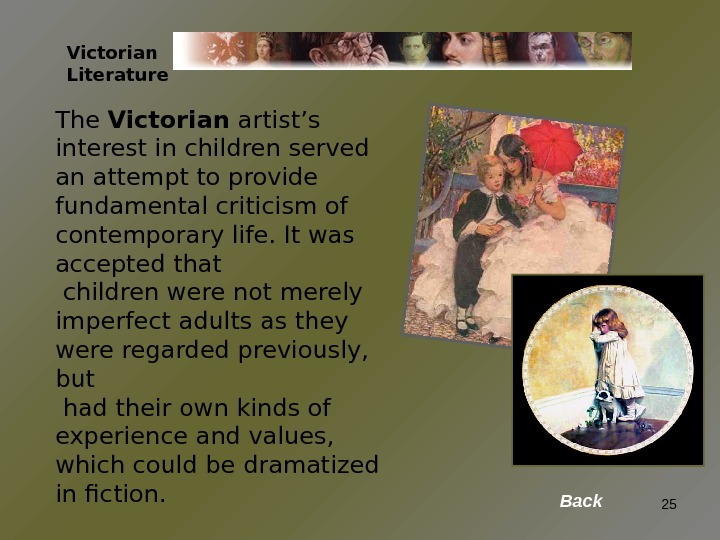
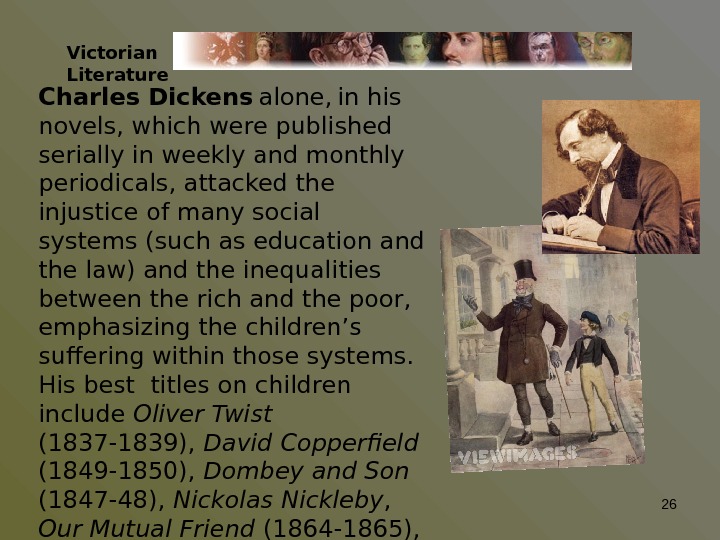
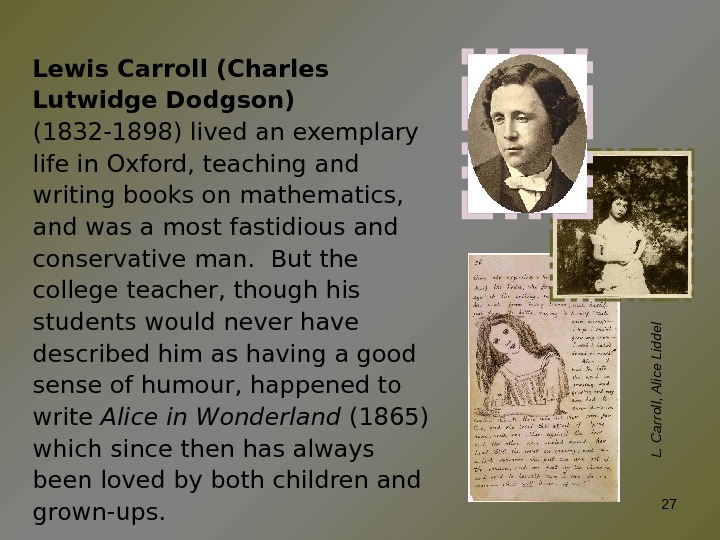
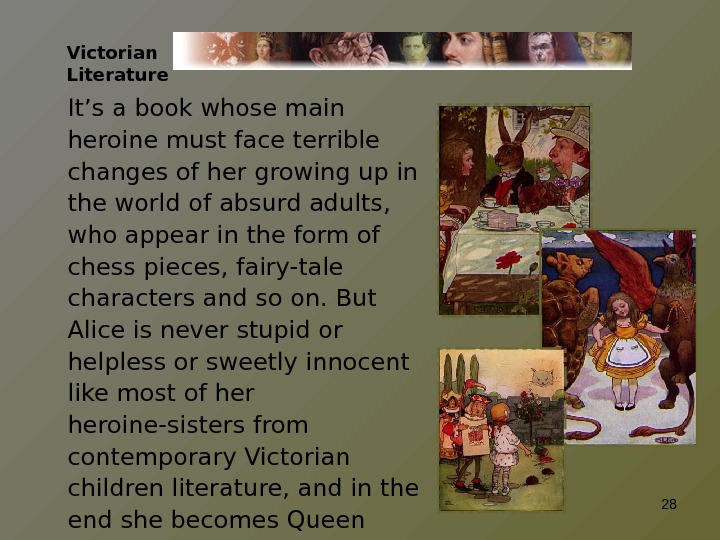
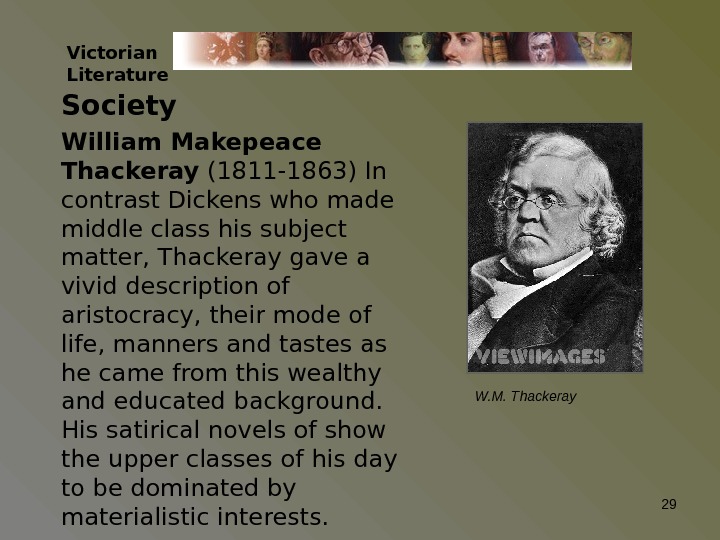
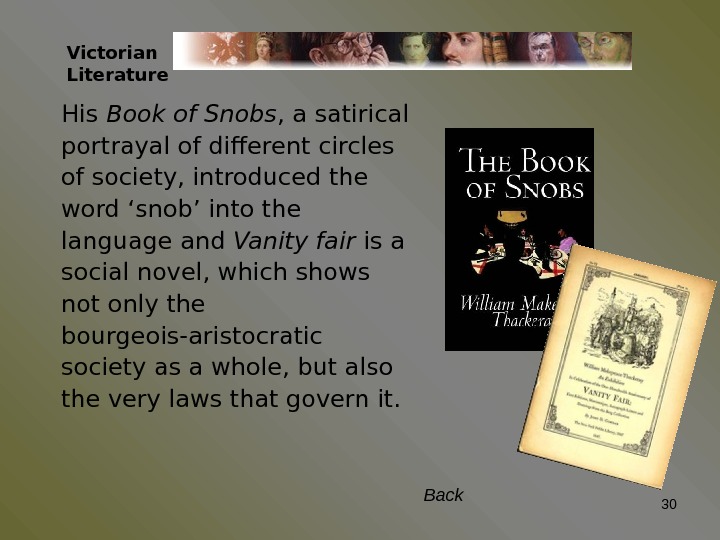
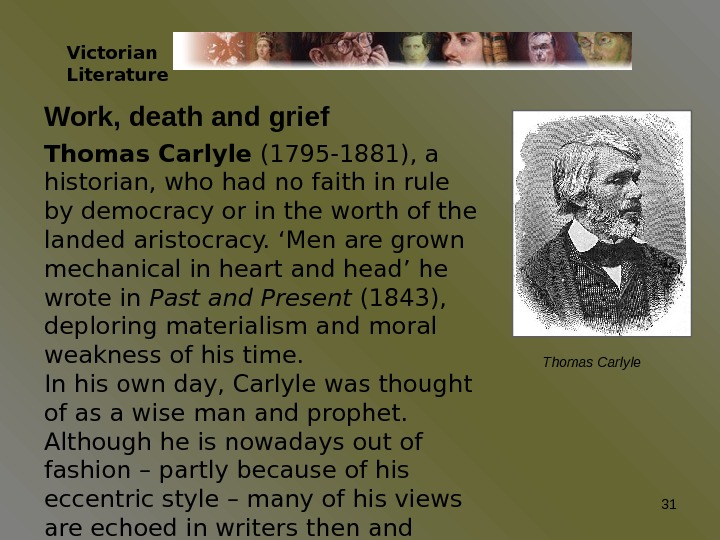
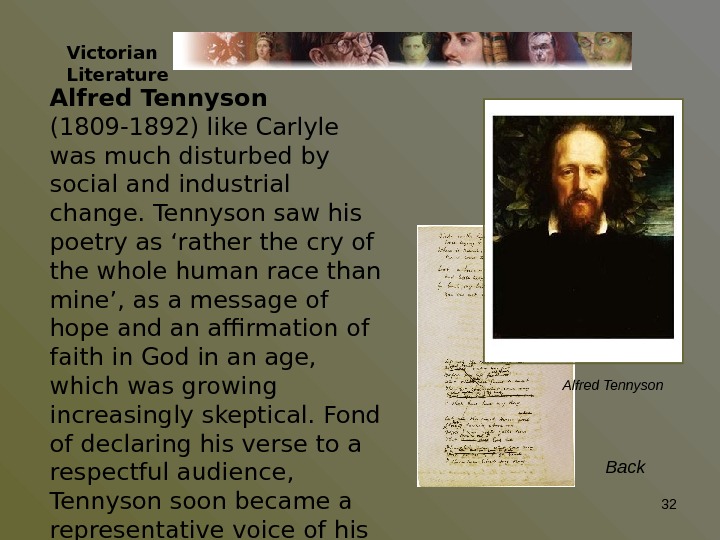
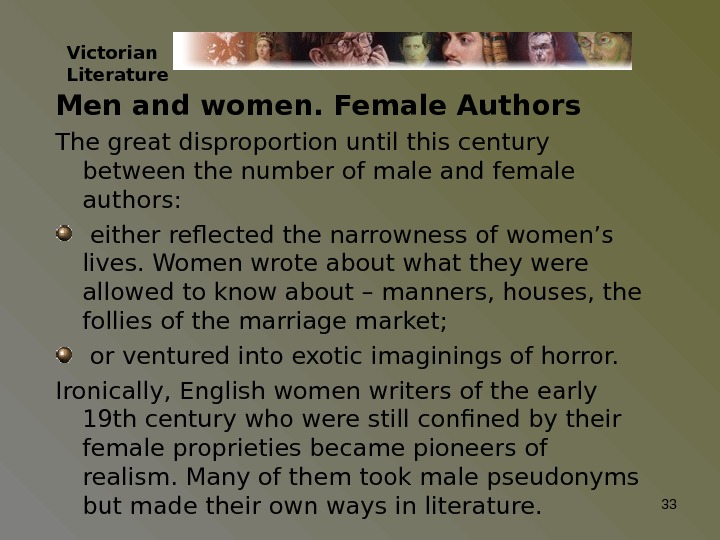
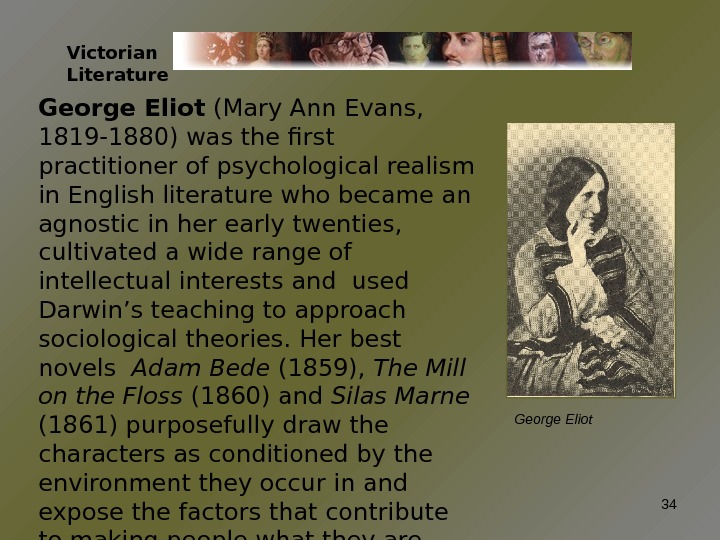
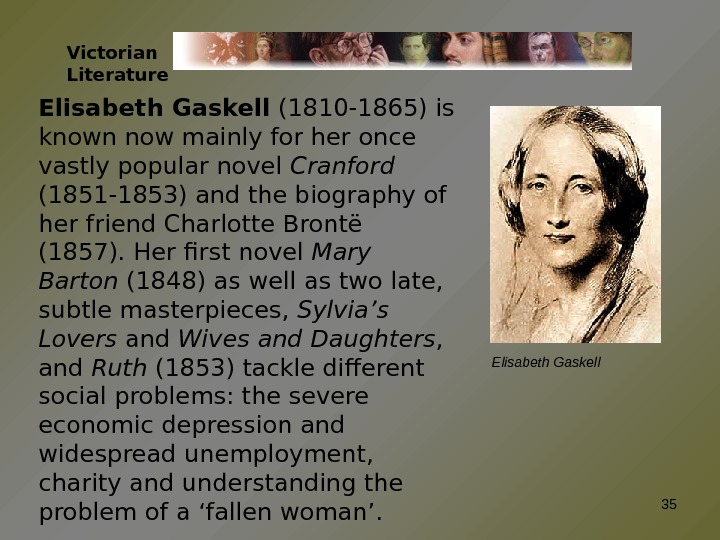
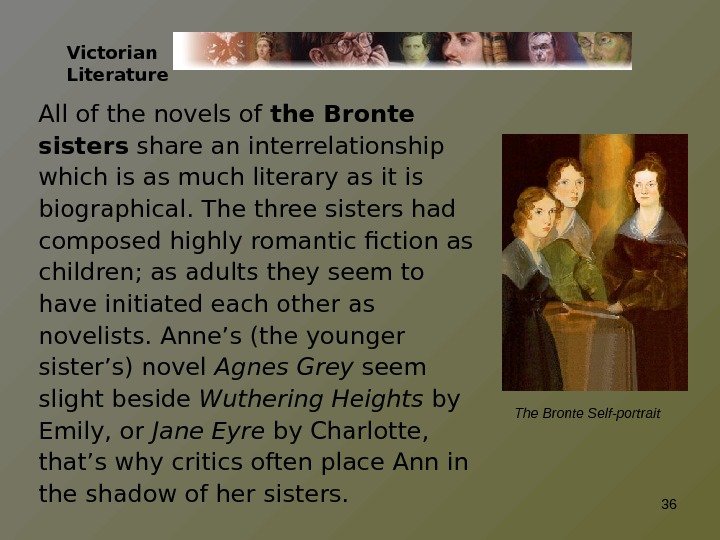
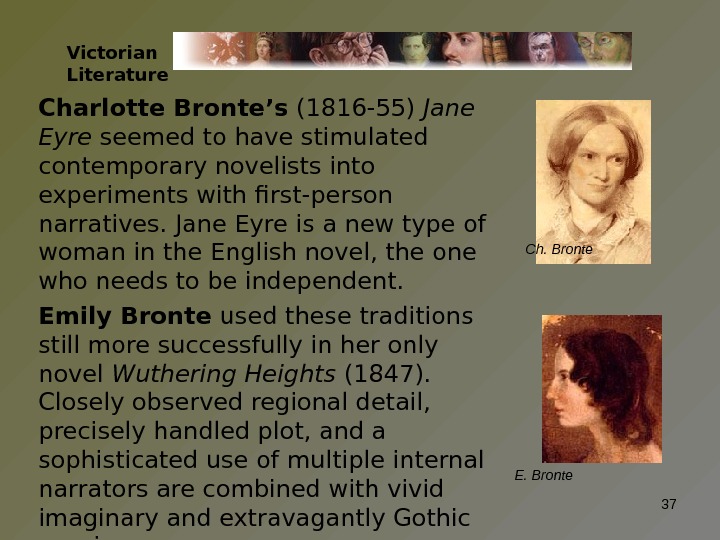
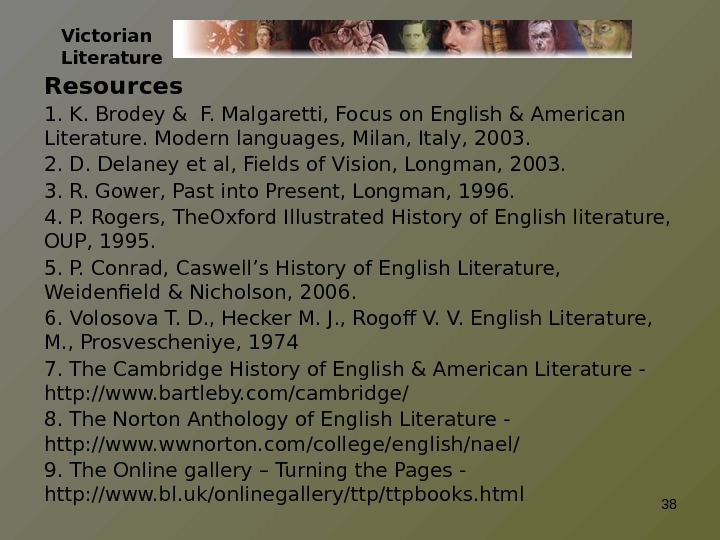
- Размер: 2.6 Mегабайта
- Количество слайдов: 38
Описание презентации High Victorian Literature (1837 – 1870) 1 по слайдам
 High Victorian Literature (1837 – 1870)
High Victorian Literature (1837 – 1870)
 Historical & Social Background Reviews & Readers Religion, Society & the Novel Victorian Literary Themes. Victorian Literature
Historical & Social Background Reviews & Readers Religion, Society & the Novel Victorian Literary Themes. Victorian Literature
 Victorian Literature In many ways the first decades of the 19 th century was the age of progress : it became the age of railways, steamships, growth of mechanization and scientific discoveries. But at the same time it was the age of contradictions : profound social unrest, injustice and ugliness, and, on top of all, exploitation of women and children in dirty factories and working houses and unhumanly long hours of work and low wages became the characteristic features of the period.
Victorian Literature In many ways the first decades of the 19 th century was the age of progress : it became the age of railways, steamships, growth of mechanization and scientific discoveries. But at the same time it was the age of contradictions : profound social unrest, injustice and ugliness, and, on top of all, exploitation of women and children in dirty factories and working houses and unhumanly long hours of work and low wages became the characteristic features of the period.
 Victorian Literature It was officially acknowledged that industrial interests in Britain were now more important than traditional agriculture. The Industrial Revolution was complete and the Great Exhibition in London in 1851 was its high point. Britain had become the ‘workshop of the world’. British Empire,
Victorian Literature It was officially acknowledged that industrial interests in Britain were now more important than traditional agriculture. The Industrial Revolution was complete and the Great Exhibition in London in 1851 was its high point. Britain had become the ‘workshop of the world’. British Empire,
 Victorian Literature At the same time there was great urban poverty and social injustice. Between 1837 and 1848 the Chartist Movement signaled the emergence of the working class movement as a political force. The Chartist Movement was so called because of its Charter (1833) of six points, which included the right of all males to vote. The Chartist Movement introduced its own literature: the first attempt to create a literature of the working class. They tried their hand in many genres: political articles, short stories, epigrams, and songs and poems.
Victorian Literature At the same time there was great urban poverty and social injustice. Between 1837 and 1848 the Chartist Movement signaled the emergence of the working class movement as a political force. The Chartist Movement was so called because of its Charter (1833) of six points, which included the right of all males to vote. The Chartist Movement introduced its own literature: the first attempt to create a literature of the working class. They tried their hand in many genres: political articles, short stories, epigrams, and songs and poems.
 Victorian Literature It employed the motives of folk poetry combining it with dealing with the burning problems of their life. The Chartist poetry became extremely popular among the working people: it showed the inhuman conditions of life and work, the miserable fate of the poor. The best known works belong to the leader of the Movement and the poet Ernest Jones ( The Song of the Lower Classes) and Thomas Good ( The Song of the Shirt ). The Chartist Movement lasted till 1848. Between 1851 and 1870 discontent subsided and Britain was at the height of her wealth and influence.
Victorian Literature It employed the motives of folk poetry combining it with dealing with the burning problems of their life. The Chartist poetry became extremely popular among the working people: it showed the inhuman conditions of life and work, the miserable fate of the poor. The best known works belong to the leader of the Movement and the poet Ernest Jones ( The Song of the Lower Classes) and Thomas Good ( The Song of the Shirt ). The Chartist Movement lasted till 1848. Between 1851 and 1870 discontent subsided and Britain was at the height of her wealth and influence.
 Victorian Literature Queen Victoria (1819 -1901) became queen at seventeen. She was the first monarch to live in Buckingham Palace and reigned from 1837 to 1901. She restored the prestige of the monarchy so that when she died it was more popular than ever. Victoria had both natural liveliness and great dignity. Her personal behaviour represented to her subjects moral dignity and devotion to husband family. Q ueen Victoria
Victorian Literature Queen Victoria (1819 -1901) became queen at seventeen. She was the first monarch to live in Buckingham Palace and reigned from 1837 to 1901. She restored the prestige of the monarchy so that when she died it was more popular than ever. Victoria had both natural liveliness and great dignity. Her personal behaviour represented to her subjects moral dignity and devotion to husband family. Q ueen Victoria
 Victorian Literature Parliamentary politics was dominated by the conflicts between Benjamin Disraeli (1804 -1881) and William Gladstone (1809 -1898). Disraeli won the Queen’s confidence and promoted British power abroad. He recognized that the monarchy was an effective symbolic head of the Empire and in 1877 encouraged Victoria to adopt the title of Empress of India. Disraeli by John Mallais
Victorian Literature Parliamentary politics was dominated by the conflicts between Benjamin Disraeli (1804 -1881) and William Gladstone (1809 -1898). Disraeli won the Queen’s confidence and promoted British power abroad. He recognized that the monarchy was an effective symbolic head of the Empire and in 1877 encouraged Victoria to adopt the title of Empress of India. Disraeli by John Mallais
 Victorian Literature Gladstone, four times Prime Minister for the Liberals, formerly known as the ‘Whigs’ lacked the charm of his rival but had great energy and seriousness. He supported social reform at home and justice for the weaker nations abroad. William Gladstone
Victorian Literature Gladstone, four times Prime Minister for the Liberals, formerly known as the ‘Whigs’ lacked the charm of his rival but had great energy and seriousness. He supported social reform at home and justice for the weaker nations abroad. William Gladstone
 Victorian Literature At its height the British Empire covered a quarter of the earth’s surface. In the 18 th and 19 th centuries it took place particularly in Africa but also Australia, New Zealand Egypt. Interestingly, expansion of the Empire was mainly unorganized and carried bit by bit, with the British Government often being less interested than the trading companies. British Empire 1886 & British Empire in America
Victorian Literature At its height the British Empire covered a quarter of the earth’s surface. In the 18 th and 19 th centuries it took place particularly in Africa but also Australia, New Zealand Egypt. Interestingly, expansion of the Empire was mainly unorganized and carried bit by bit, with the British Government often being less interested than the trading companies. British Empire 1886 & British Empire in America
 Victorian Literature The society changed very much with the changes in economy and science. Scientific scholarship on biblical texts and contemporary theories concerning the geological development of the earth had already caused intellectuals to have religious doubts. From Past Tense of Photo Collection
Victorian Literature The society changed very much with the changes in economy and science. Scientific scholarship on biblical texts and contemporary theories concerning the geological development of the earth had already caused intellectuals to have religious doubts. From Past Tense of Photo Collection
 Traditional beliefs were more widely shaken by the controversy caused by theories of evolution, e. g. Charles Darwin’s (1809 -1882) On the Origin of Species by means of Natural Selection (1859) and The Descent of Man (1871). Charles Darwin
Traditional beliefs were more widely shaken by the controversy caused by theories of evolution, e. g. Charles Darwin’s (1809 -1882) On the Origin of Species by means of Natural Selection (1859) and The Descent of Man (1871). Charles Darwin
 Victorian Literature In writing though several major figures of English Romanticism lived on into this period, the critics felt there had been a break in English literary tradition, which they identified with the death of Byron in 1824, and the deaths of Jane Austen in 1817 and Sir Walter Scott in 1832 and which should have been seen as even more significant, as the new literary era has been seen as the age of the novel. Victorian Periodicals
Victorian Literature In writing though several major figures of English Romanticism lived on into this period, the critics felt there had been a break in English literary tradition, which they identified with the death of Byron in 1824, and the deaths of Jane Austen in 1817 and Sir Walter Scott in 1832 and which should have been seen as even more significant, as the new literary era has been seen as the age of the novel. Victorian Periodicals
 Victorian Literature A new literary trend – critical realism – became predominant. It was the method of a truthful presentation of objective reality. Realism implies realistic details and typical characters acting under typical circumstances. The trend reached its height in the Victorian literature with its predisposition to real life and exposure of the contradictions of the contemporary society. The prevailing literary form was the novel.
Victorian Literature A new literary trend – critical realism – became predominant. It was the method of a truthful presentation of objective reality. Realism implies realistic details and typical characters acting under typical circumstances. The trend reached its height in the Victorian literature with its predisposition to real life and exposure of the contradictions of the contemporary society. The prevailing literary form was the novel.
 Victorian Literature Critical realism employs: revealing character through physical description , i. e. uses the character’s physical traits to convey information about his identity. The physical description may be extremely detailed with the writer repeatedly referring to some aspect of a character’s appearance. revealing character through dialogue. What a character says in the form of dialogue provides information about his personality, feelings, attitude towards self and others, moral views, origins, education and social class.
Victorian Literature Critical realism employs: revealing character through physical description , i. e. uses the character’s physical traits to convey information about his identity. The physical description may be extremely detailed with the writer repeatedly referring to some aspect of a character’s appearance. revealing character through dialogue. What a character says in the form of dialogue provides information about his personality, feelings, attitude towards self and others, moral views, origins, education and social class.
 Omnipresent obtrusive narrator who is both a storyteller and a commentator. He interrupts the narrative and uses it as a starting point for some comment or generalisation he wishes to make. He may step into the story for various reasons and can: sum up past events and anticipate future developments in the story; provide missing information; comment on what is happening in the story; make generalisations; moralise and philosophise; guide the reader’s interpretation; digress on subjects that have little or nothing to do with the story.
Omnipresent obtrusive narrator who is both a storyteller and a commentator. He interrupts the narrative and uses it as a starting point for some comment or generalisation he wishes to make. He may step into the story for various reasons and can: sum up past events and anticipate future developments in the story; provide missing information; comment on what is happening in the story; make generalisations; moralise and philosophise; guide the reader’s interpretation; digress on subjects that have little or nothing to do with the story.
 Victorian Literature One reason for the development of the novel was the desire by the reading public to understand the huge social changes of the time. By the year 1847 there had been four hundred libraries in England with the middle class as their main readers. In the first year of publication of Athenaum Henry Stebbing , the journal’s editor, compared it with the ‘most powerful literary engine in Europe’. Victorian Periodicals
Victorian Literature One reason for the development of the novel was the desire by the reading public to understand the huge social changes of the time. By the year 1847 there had been four hundred libraries in England with the middle class as their main readers. In the first year of publication of Athenaum Henry Stebbing , the journal’s editor, compared it with the ‘most powerful literary engine in Europe’. Victorian Periodicals
 Victorian Literature published in the weekly, fortnightly, monthly or quarterly periodicals, novels in cheap monthly parts, poetry in illustrated annuals had an unpresendented influence largely because: an increase in population providing an audience; a steady expansion of education, both for the rich and the poor; above all cheaper printing, lower prices for periodicals and their speedy circulation due to the efficient technology.
Victorian Literature published in the weekly, fortnightly, monthly or quarterly periodicals, novels in cheap monthly parts, poetry in illustrated annuals had an unpresendented influence largely because: an increase in population providing an audience; a steady expansion of education, both for the rich and the poor; above all cheaper printing, lower prices for periodicals and their speedy circulation due to the efficient technology.
 Victorian Literature Such intelligence of the reader was readily assumed and taken for granted. The great Victorian journals and newspapers provided public forum for discussion of domestic and foreign politics, debates over religious certainties and difficulties, speculations on the contemporary society and detailed criticism of the state of literature. Victorian Periodicals
Victorian Literature Such intelligence of the reader was readily assumed and taken for granted. The great Victorian journals and newspapers provided public forum for discussion of domestic and foreign politics, debates over religious certainties and difficulties, speculations on the contemporary society and detailed criticism of the state of literature. Victorian Periodicals
 Victorian Literature Obviously not all the journals were aimed at an educational highbrow reader. The literary Annuals , associated with Lady Blessington, were aimed at middle class, middlebrow women. Ainsworth’s Magazine provided fiction which Dickens had once described as ‘commonplace’. The Edinburgh Review, The Quarterly, Fraser’s Magazine , or Westminster included new fiction and poetry, articles and reviews. Victorian Periodicals
Victorian Literature Obviously not all the journals were aimed at an educational highbrow reader. The literary Annuals , associated with Lady Blessington, were aimed at middle class, middlebrow women. Ainsworth’s Magazine provided fiction which Dickens had once described as ‘commonplace’. The Edinburgh Review, The Quarterly, Fraser’s Magazine , or Westminster included new fiction and poetry, articles and reviews. Victorian Periodicals
 Victorian Literature But all of them, the greatest and not so great, were illustrated by the finest English artists available and attracted most of the best working novelists to their pages to fulfill their aim to inform and entertain the reader. Victorian novelists took their duty to stimulate people’s conscience and make the society more sensitive. The literature of the age was best represented by Charles Dickens, William Makepeace Thackeray, sisters Brontë, Thomas Carlyle, Alfred Tennyson, George Eliot, Henry James and others. Victorian Periodicals
Victorian Literature But all of them, the greatest and not so great, were illustrated by the finest English artists available and attracted most of the best working novelists to their pages to fulfill their aim to inform and entertain the reader. Victorian novelists took their duty to stimulate people’s conscience and make the society more sensitive. The literature of the age was best represented by Charles Dickens, William Makepeace Thackeray, sisters Brontë, Thomas Carlyle, Alfred Tennyson, George Eliot, Henry James and others. Victorian Periodicals
 Victorian Literature Religion, Society, and the Novel The so-called age of reform made the Church shudder as much as the state. The bishops who had voted against the bill in the House of Lords were publicly, even physically, abused in a way that indicates a widespread and uncommon anticlericalism and atheism. But it was State interference with the Church government that stimulated a very different reaction in the University of Oxford in 1833. It also inspired the worst kind of narrow poetry and gave a revival of interest in the 17 th century religious verse, and set a pattern for a new generation of Christian poets, the ones like Christina Rossetti.
Victorian Literature Religion, Society, and the Novel The so-called age of reform made the Church shudder as much as the state. The bishops who had voted against the bill in the House of Lords were publicly, even physically, abused in a way that indicates a widespread and uncommon anticlericalism and atheism. But it was State interference with the Church government that stimulated a very different reaction in the University of Oxford in 1833. It also inspired the worst kind of narrow poetry and gave a revival of interest in the 17 th century religious verse, and set a pattern for a new generation of Christian poets, the ones like Christina Rossetti.
 Victorian Literature Victorian literary themes Childhood Society Work, death and grief Men and women. From Past Tense of Photo C ollection
Victorian Literature Victorian literary themes Childhood Society Work, death and grief Men and women. From Past Tense of Photo C ollection
 Childhood Before the Romantic poets, childhood had not been an important literary theme in English literature. In most Romantic works the child was represented as • ‘ innocent’. • a symbol of the artist’s dissatisfaction with a rapidly-changing society.
Childhood Before the Romantic poets, childhood had not been an important literary theme in English literature. In most Romantic works the child was represented as • ‘ innocent’. • a symbol of the artist’s dissatisfaction with a rapidly-changing society.
 The Victorian artist’s interest in children served an attempt to provide fundamental criticism of contemporary life. It was accepted that children were not merely imperfect adults as they were regarded previously, but had their own kinds of experience and values, which could be dramatized in fiction. Victorian Literature Back
The Victorian artist’s interest in children served an attempt to provide fundamental criticism of contemporary life. It was accepted that children were not merely imperfect adults as they were regarded previously, but had their own kinds of experience and values, which could be dramatized in fiction. Victorian Literature Back
 Victorian Literature Charles Dickens alone, in his novels, which were published serially in weekly and monthly periodicals, attacked the injustice of many social systems (such as education and the law) and the inequalities between the rich and the poor, emphasizing the children’s suffering within those systems. His best titles on children include Oliver Twist (1837 -1839), David Copperfield (1849 -1850), Dombey and Son (1847 -48), Nickolas Nickleby , Our Mutual Friend (1864 -1865), etc.
Victorian Literature Charles Dickens alone, in his novels, which were published serially in weekly and monthly periodicals, attacked the injustice of many social systems (such as education and the law) and the inequalities between the rich and the poor, emphasizing the children’s suffering within those systems. His best titles on children include Oliver Twist (1837 -1839), David Copperfield (1849 -1850), Dombey and Son (1847 -48), Nickolas Nickleby , Our Mutual Friend (1864 -1865), etc.
 Lewis Carroll (Charles Lutwidge Dodgson) (1832 -1898) lived an exemplary life in Oxford, teaching and writing books on mathematics, and was a most fastidious and conservative man. But the college teacher, though his students would never have described him as having a good sense of humour, happened to write Alice in Wonderland (1865) which since then has always been loved by both children and grown-ups. L. C arroll, Alice Liddel
Lewis Carroll (Charles Lutwidge Dodgson) (1832 -1898) lived an exemplary life in Oxford, teaching and writing books on mathematics, and was a most fastidious and conservative man. But the college teacher, though his students would never have described him as having a good sense of humour, happened to write Alice in Wonderland (1865) which since then has always been loved by both children and grown-ups. L. C arroll, Alice Liddel
 It’s a book whose main heroine must face terrible changes of her growing up in the world of absurd adults, who appear in the form of chess pieces, fairy-tale characters and so on. But Alice is never stupid or helpless or sweetly innocent like most of heroine-sisters from contemporary Victorian children literature, and in the end she becomes Queen Alice. Victorian Literature
It’s a book whose main heroine must face terrible changes of her growing up in the world of absurd adults, who appear in the form of chess pieces, fairy-tale characters and so on. But Alice is never stupid or helpless or sweetly innocent like most of heroine-sisters from contemporary Victorian children literature, and in the end she becomes Queen Alice. Victorian Literature
 Victorian Literature Society William Makepeace Thackeray (1811 -1863) In contrast Dickens who made middle class his subject matter, Thackeray gave a vivid description of aristocracy, their mode of life, manners and tastes as he came from this wealthy and educated background. His satirical novels of show the upper classes of his day to be dominated by materialistic interests. W. M. Thackeray
Victorian Literature Society William Makepeace Thackeray (1811 -1863) In contrast Dickens who made middle class his subject matter, Thackeray gave a vivid description of aristocracy, their mode of life, manners and tastes as he came from this wealthy and educated background. His satirical novels of show the upper classes of his day to be dominated by materialistic interests. W. M. Thackeray
 Victorian Literature His Book of Snobs , a satirical portrayal of different circles of society, introduced the word ‘snob’ into the language and Vanity fair is a social novel, which shows not only the bourgeois-aristocratic society as a whole, but also the very laws that govern it. Back
Victorian Literature His Book of Snobs , a satirical portrayal of different circles of society, introduced the word ‘snob’ into the language and Vanity fair is a social novel, which shows not only the bourgeois-aristocratic society as a whole, but also the very laws that govern it. Back
 Victorian Literature Work, death and grief Thomas Carlyle (1795 -1881), a historian, who had no faith in rule by democracy or in the worth of the landed aristocracy. ‘Men are grown mechanical in heart and head’ he wrote in Past and Present (1843), deploring materialism and moral weakness of his time. In his own day, Carlyle was thought of as a wise man and prophet. Although he is nowadays out of fashion – partly because of his eccentric style – many of his views are echoed in writers then and since. Thomas Carlyle
Victorian Literature Work, death and grief Thomas Carlyle (1795 -1881), a historian, who had no faith in rule by democracy or in the worth of the landed aristocracy. ‘Men are grown mechanical in heart and head’ he wrote in Past and Present (1843), deploring materialism and moral weakness of his time. In his own day, Carlyle was thought of as a wise man and prophet. Although he is nowadays out of fashion – partly because of his eccentric style – many of his views are echoed in writers then and since. Thomas Carlyle
 Victorian Literature Alfred Tennyson (1809 -1892) like Carlyle was much disturbed by social and industrial change. Tennyson saw his poetry as ‘rather the cry of the whole human race than mine’, as a message of hope and an affirmation of faith in God in an age, which was growing increasingly skeptical. Fond of declaring his verse to a respectful audience, Tennyson soon became a representative voice of his age. Alfred Tennyson Back
Victorian Literature Alfred Tennyson (1809 -1892) like Carlyle was much disturbed by social and industrial change. Tennyson saw his poetry as ‘rather the cry of the whole human race than mine’, as a message of hope and an affirmation of faith in God in an age, which was growing increasingly skeptical. Fond of declaring his verse to a respectful audience, Tennyson soon became a representative voice of his age. Alfred Tennyson Back
 Men and women. Female Authors The great disproportion until this century between the number of male and female authors: either reflected the narrowness of women’s lives. Women wrote about what they were allowed to know about – manners, houses, the follies of the marriage market; or ventured into exotic imaginings of horror. Ironically, English women writers of the early 19 th century who were still confined by their female proprieties became pioneers of realism. Many of them took male pseudonyms but made their own ways in literature. Victorian Literature
Men and women. Female Authors The great disproportion until this century between the number of male and female authors: either reflected the narrowness of women’s lives. Women wrote about what they were allowed to know about – manners, houses, the follies of the marriage market; or ventured into exotic imaginings of horror. Ironically, English women writers of the early 19 th century who were still confined by their female proprieties became pioneers of realism. Many of them took male pseudonyms but made their own ways in literature. Victorian Literature
 Victorian Literature George Eliot (Mary Ann Evans, 1819 -1880) was the first practitioner of psychological realism in English literature who became an agnostic in her early twenties, cultivated a wide range of intellectual interests and used Darwin’s teaching to approach sociological theories. Her best novels Adam Bede (1859), The Mill on the Floss (1860) and Silas Marne (1861) purposefully draw the characters as conditioned by the environment they occur in and expose the factors that contribute to making people what they are. George Eliot
Victorian Literature George Eliot (Mary Ann Evans, 1819 -1880) was the first practitioner of psychological realism in English literature who became an agnostic in her early twenties, cultivated a wide range of intellectual interests and used Darwin’s teaching to approach sociological theories. Her best novels Adam Bede (1859), The Mill on the Floss (1860) and Silas Marne (1861) purposefully draw the characters as conditioned by the environment they occur in and expose the factors that contribute to making people what they are. George Eliot
 Victorian Literature Elisabeth Gaskell (1810 -1865) is known now mainly for her once vastly popular novel Cranford (1851 -1853) and the biography of her friend Charlotte Brontë (1857). Her first novel Mary Barton (1848) as well as two late, subtle masterpieces, Sylvia’s Lovers and Wives and Daughters , and Ruth (1853) tackle different social problems: the severe economic depression and widespread unemployment, charity and understanding the problem of a ‘fallen woman’. Elisabeth Gaskell
Victorian Literature Elisabeth Gaskell (1810 -1865) is known now mainly for her once vastly popular novel Cranford (1851 -1853) and the biography of her friend Charlotte Brontë (1857). Her first novel Mary Barton (1848) as well as two late, subtle masterpieces, Sylvia’s Lovers and Wives and Daughters , and Ruth (1853) tackle different social problems: the severe economic depression and widespread unemployment, charity and understanding the problem of a ‘fallen woman’. Elisabeth Gaskell
 Victorian Literature All of the novels of the Bronte sisters share an interrelationship which is as much literary as it is biographical. The three sisters had composed highly romantic fiction as children; as adults they seem to have initiated each other as novelists. Anne’s (the younger sister’s) novel Agnes Grey seem slight beside Wuthering Heights by Emily, or Jane Eyre by Charlotte, that’s why critics often place Ann in the shadow of her sisters. The Bronte Self-portrait
Victorian Literature All of the novels of the Bronte sisters share an interrelationship which is as much literary as it is biographical. The three sisters had composed highly romantic fiction as children; as adults they seem to have initiated each other as novelists. Anne’s (the younger sister’s) novel Agnes Grey seem slight beside Wuthering Heights by Emily, or Jane Eyre by Charlotte, that’s why critics often place Ann in the shadow of her sisters. The Bronte Self-portrait
 Charlotte Bronte’s (1816 -55) Jane Eyre seemed to have stimulated contemporary novelists into experiments with first-person narratives. Jane Eyre is a new type of woman in the English novel, the one who needs to be independent. Emily Bronte used these traditions still more successfully in her only novel Wuthering Heights (1847). Closely observed regional detail, precisely handled plot, and a sophisticated use of multiple internal narrators are combined with vivid imaginary and extravagantly Gothic passions. Victorian Literature Ch. Bronte E. Bronte
Charlotte Bronte’s (1816 -55) Jane Eyre seemed to have stimulated contemporary novelists into experiments with first-person narratives. Jane Eyre is a new type of woman in the English novel, the one who needs to be independent. Emily Bronte used these traditions still more successfully in her only novel Wuthering Heights (1847). Closely observed regional detail, precisely handled plot, and a sophisticated use of multiple internal narrators are combined with vivid imaginary and extravagantly Gothic passions. Victorian Literature Ch. Bronte E. Bronte
 Victorian Literature Resources 1. K. Brodey & F. Malgaretti, Focus on English & American Literature. Modern languages, Milan, Italy, 2003. 2. D. Delaney et al, Fields of Vision, Longman, 2003. 3. R. Gower, Past into Present, Longman, 1996. 4. P. Rogers, The. Oxford Illustrated History of English literature, OUP, 1995. 5. P. Conrad, Caswell’s History of English Literature, Weidenfield & Nicholson, 2006. 6. Volosova T. D. , Hecker M. J. , Rogoff V. V. English Literature, M. , Prosvescheniye, 1974 7. The Cambridge History of English & American Literature — http: //www. bartleby. com/cambridge/ 8. The Norton Anthology of English Literature — http: //www. wwnorton. com/college/english/nael/ 9. The Online gallery – Turning the Pages — http: //www. bl. uk/onlinegallery/ttpbooks. html
Victorian Literature Resources 1. K. Brodey & F. Malgaretti, Focus on English & American Literature. Modern languages, Milan, Italy, 2003. 2. D. Delaney et al, Fields of Vision, Longman, 2003. 3. R. Gower, Past into Present, Longman, 1996. 4. P. Rogers, The. Oxford Illustrated History of English literature, OUP, 1995. 5. P. Conrad, Caswell’s History of English Literature, Weidenfield & Nicholson, 2006. 6. Volosova T. D. , Hecker M. J. , Rogoff V. V. English Literature, M. , Prosvescheniye, 1974 7. The Cambridge History of English & American Literature — http: //www. bartleby. com/cambridge/ 8. The Norton Anthology of English Literature — http: //www. wwnorton. com/college/english/nael/ 9. The Online gallery – Turning the Pages — http: //www. bl. uk/onlinegallery/ttpbooks. html

